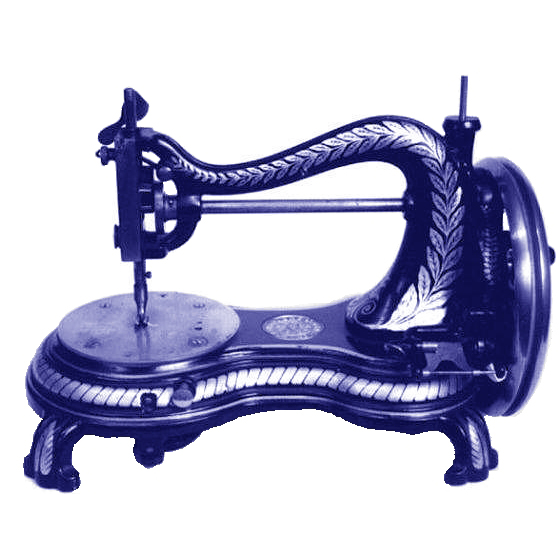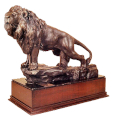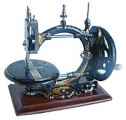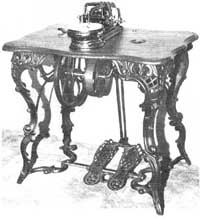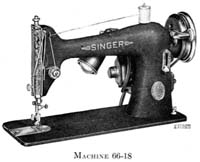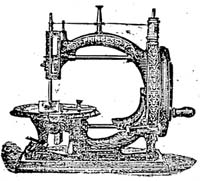Frederick Cookson
WE FIRST hear of Frederick Nesfield Cookson on August 11 1886 when he submitted his first patent application.
From this we learn that he lived at Eva Villa, Walerloo Road, Wolverhampton. He described himself as a manufacturer, but it is now likely that he was producing sewing machines at this time.
The patent was for an improved shuttle mechanism designed to give a pause to the shuttle's movement. Cookson claimed that while the invention was ideally suited to a small portable machine, the idea would also be of advantage on full-size machines.
In essence it was a toothed rack and pinion with a bell crank. Such an idea would have been very noisy and highly susceptible to wear. I do not believe that it was ever fitted to a production machine.
A month later another patent followed still using the bell-crank idea but with a simple connecting rod in place of the rack and pinion. This patent also included the trap-door mechanism for shuttle removal which was subsequently used on the production machines.
His next patent of June 1887 was for various improvements on the previous design and provided the shuttle-carrier transport mechanism with a pair of steel-shaft runners as used on Royal machines. The drawing for this patent shows the general outline of the machine as we know it today. By October 1887 he had moved to premises in Lozells Road, Birmingham, and his last patent of this date shows the machine in its final production form.
A company was formed with Samuel Jenkins and James Frederick Fairley as co-directors and the business enjoyed limited success for a short period, but then things started to go wrong.
In 1888 it became apparent that the Cookson Lock Stitch Sewing Machine Company was not able to pay its bills for the machinery it had purchased to build the machines.
Most of the gear-cutting equipment was obtained from the English Watch Company of Birmingham and it was this concern that took Cookson to court.
There it was revealed that the Cookson company had been making excuse after excuse for 18 months and the English Watch Company's action was for £111 7s plus damages for fraud and misrepresentation.
In court an eminent QC acting on behalf of the plaintiffs revealed that, after much chasing of the bill, Cookson had at one stage passed over a post-dated cheque with the promise to honor it when it became due in 30 days time.
A lot happened in those 30 days.
The Cookson Lock Stitch Sewing Machine Company went into voluntary liquidation and out of the ashes came the Cookson Patent Sewing Machine Company with Jenkins and Fairley as Directors and Cookson himself as company secretary.
An earlier court hearing had held that the new company was still liable for the debt and the English Watch Company sat back and waited for its money. Instead it received a visit from Cookson who said that the debt could not be "conventionally paid" at that time but suggested that a further 30 days grace would make all the difference,
This was agreed.
Just before the new deadline the English Watch Company's directors were surprised to find a deputation waiting for them one morning in their own board room. It was Cookson, Fairley and Jenkins.
The bill could, of course, be paid now, they explained but, because the English Watch Company had been such understanding business partners, the Cookson board had decided to let them in on a "good thing".
Business was booming in Lozells Road and for the good faith over the past months the Cookson management was going to issue free shares in its business to the English Watch Company. In exchange for this, perhaps an further extension on the bill, this time for three months should be considered .....
Surprisingly the English Watch Company agreed.
They were never paid out and eventually took Cookson to court where investigations revealed that no shares had ever been transferred.
Before the court case came to an end the Cookson Patent Sewing Machine Company went into liquidation leaving the English Watch concern nothing for its trouble save considerable court costs.
And that would have been the end of the story but for a small advertisement that appeared just once in the Journal of Domestic Appliance on March 1, 1890. It was for the Handy Machine priced at £1 10s (£1.50).
In fact it was a cleaned-up, streamlined, version of the Cookson and much more conventional that its anachronistic predecessor.
The manufacturer was given as Harpur & Mason. It had the same trap-door feature and an identical shuttle, but the telling point was the address of the company - 22-24 Lozells Road, Birmingham, just across the road from the old Cookson concern.
Just who Harpur and Mason were I've yet to discover, but certainly their sewing-machine business was, if anything, less successful than Cookson's.
From records and experience in handling the Cookson machine, it's likely that fewer than 500 were ever produced. Serial numbers of the dozen or so still extant range from 300 to 800, so it's a fair bet that the company started at number 300 and produced around 500 machines at best, assuming that they numbered consecutively and didn't jump a few hundred to impress their customers and agents.
The Handy is a different story.
Only one seems to have survived. Originally in the collection of former ISMACS chairman Brian Mathews, it changed hands, going to ISMACS secretary Maggie Snell a few years ago.
